�
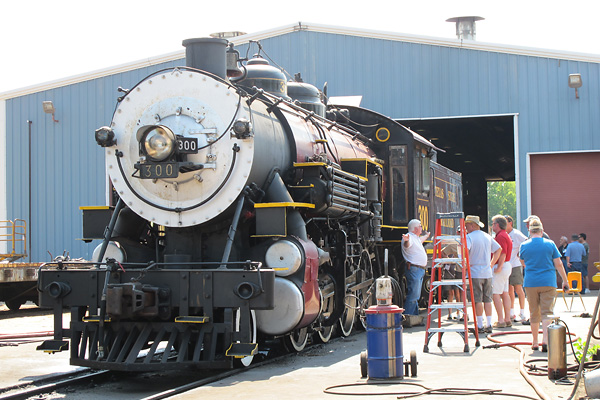
�
Number 300 is a "Pershing" engine, built by Baldwin Locomotive Works in 1917 for the United States Army
�
to use in Europe during WWI. Only two Pershing engines survive. Instead of being shipped to Europe
�
this one was assigned to Camp Polk Army Base in Leesville, Louisiana. After that, it had a long career
�
of hauling lumber for private railroads in Louisiana and East Texas. Engine number 300 weighs
�
83 tons and it can produce a tractive effort of 35,610 pounds.
�
BritishV8 2012: Visit to the Texas State Railway Maintenance Facility
��
as published in BritishV8 Magazine, Volume XX Issue 1, July 2012�
�
by Curtis Jacobson, with technical notes by Larry Shimp�
�
Rusk to Palestine or Bust
��
One highlight of our 2012 BritishV8 meet was a guided tour of the Texas State Railway's maintenance�
facility at 2503 West 6th Street in Rusk, Texas. The railway operates both steam and early�
diesel-electric powered locomotives between depots at Palestine and Rusk. The twenty-five mile�
route is a popular excursion for tourists. The railroad also offers educational programs and an�
evening dinner train. Its facilities have been used for many historical reenactments and for movies. �
�
Frankly, I arrived rather late due to a poorly scheduled fuel stop. I'm sure I missed many fascinating�
parts of the tour, but I did get enough to inspire further research on my own time. I'll include some�
of what I learned here. �
�
Back in the golden age of steam locomotion, public and private railroads criss-crossed the North�
American landscape, providing every sort of service imaginable. Somehow though, the private�
railroads that might have served the quiet East Texas town of Rusk decided to bypass it instead. �
This problem was greatly compounded in 1881, when a large new state prison opened in Rusk. So�
many prisoners to put to work! The prison warden thought the East Texas hills might be a splendid�
place for iron mines, and that the prison might profitably operate a smelter to produce pig iron�
billets. This would only make sense if the prison were connected to the nation's rail network.�
The warden committed to laying a spur line. Ultimately, that modest spur line evolved into�
the grandly named Texas State Railway. �
�
Prison inmates performed all the timber cutting, grading, bridge building, and track laying to�
create the spur line. Prison work groups were also provided to the adjacent Kansas & Gulf Shortline�
Railroad Company to upgrade and extend their facilities. Side spurs were built left and right to support�
the prison's growing industry. For example, lumber camps were established to supply fuel for the iron�
smelter. However, it wasn't until the 1890s that the prison railroad really took off. Under a new state�
governor named Jim Hogg, who just happened to be from Rusk, the prison was authorized to extend the�
railbed westward to connect with the International & Great Northern railroad at Palestine.�
�
Railroad building is slow work at the best of times. Railroad construction to Palestine stopped and�
started repeatedly as occupants changed at the Governor's Mansion in Austin. In January 1907�
Thomas Campbell, who just happened to be from Rusk, was sworn in as Governor and in April 1907 he�
pushed through and signed The Texas State Railway Bill. Under Campbell's authority, the railway�
between Rusk and Palestine was finally completed in July 1909. At that time, the total length of�
railbed including spurs totaled 32.5 miles.�
�
Although the original rationale for the railway was shipment of iron, iron production never really�
amounted to much in East Texas. The first back-up plan was lumber production, but in September 1909�
the huge state-owned sawmill at nearby Mewshaw (also operated by prisoners) burned to the ground.�
The Texas State Railway primarily served local passenger traffic and mixed freight. It was never�
profitable, but it managed to survive through the 1960s. From 1970 on, the railway has operated as�
a tourist attraction. From 1972 through 2006 the railway was operated by the Texas State Parks &�
Wildlife authority. In 2007 it as sold to a private company. As of this writing, it is currently�
"For Sale" again.�
�
Photos From Our Visit!
��
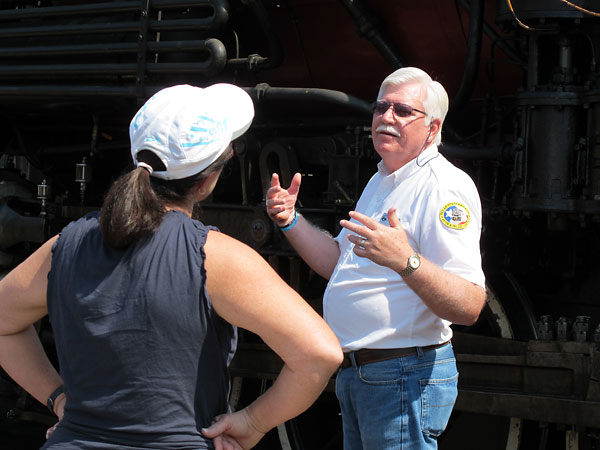
�
Jean Ingram tells Driver Eight to take a break: "Take a break, Driver Eight."
�
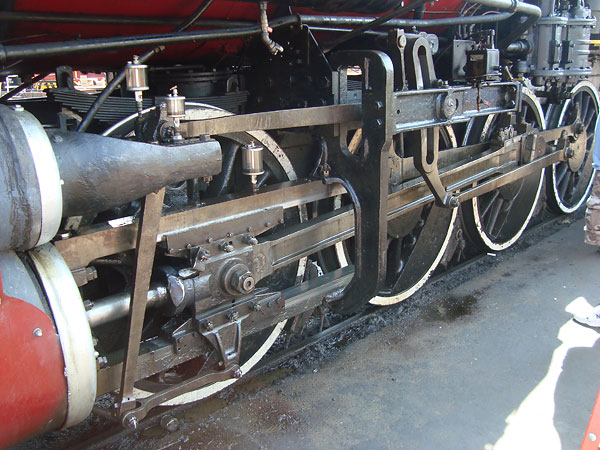
�
Actually, the nice man was telling Jean Ingram the etymology of the expression: "the real McCoy".
�
Elijah J. McCoy (1844-1929) was an African-American inventor who was awarded 57 U.S. patents.
�
McCoy achieved fame through his superior quality automatic oiler mechanisms, which dramatically
�
reduced maintenance problems for the railroad and shipping industries. Although many, many
�
competitive and copy-cat oilers were available, railroad engineers insisted on the real McCoy.
�
| �
Technical Notes:�
� Note the vertical lever with the curved slot. It provides variable valve timing and lift. (Obviously� this mechanism predates the computer controlled variable valve control mechanisms on modern cars,� by about a hundred years!) The lever oscillates from a rod connected to a crank on the middle drive� wheel. A second rod runs from the slot to the valve which is located in the housing above the drive cylinder.� � In this photo, the valve rod is in the middle position which means it doesn't move when the slotted� lever oscillates. In this position, the engine will not move even if the throttle is opened.� When the valve rod is at the bottom of the slot, the locomotive moves forward and the valve moves for� its full stroke in the forward direction of movement. When the valve rod is at the top of the slotted� lever, the locomotive runs in reverse, and the valve moves for its full reverse stroke. In other� words, it is 180 degrees out of phase from the forward running position.� � But what about in-between positions? As the valve rod is moved closer to the center of the slot, the� valve stroke decreases making the valve close earlier. This is vital to locomotive efficiency. Upon� starting, maximum torque is needed, so the full steam pressure is allowed into the cylinder for a� major part of the piston stroke. As speed increases, greater efficiency is obtained by allowing steam� into the cylinder for only a small part of the piston stroke, so that the steam can expand. This is known� as reducing the "cut off".� � The goal is to have as low an exhaust pressure as possible; letting steam out of the cylinder at high� pressure means that much of the energy in the steam is wasted. Also, as with a gasoline engine, losses� in manifolds and valves reduce efficiency and power. So, to get the maximum efficiency by having the� highest starting pressure in the cylinder and the maximum expansion, it is good practice to run a steam� locomotive with as wide open a throttle as possible, and to control speed with the cut off.� |
�
�
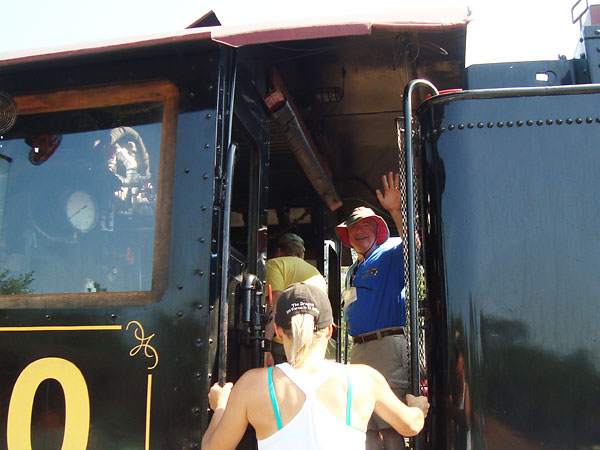
�
That's our friend Scott Costanzo in the "Thomas the Tank Engine" T-shirt.
�
�
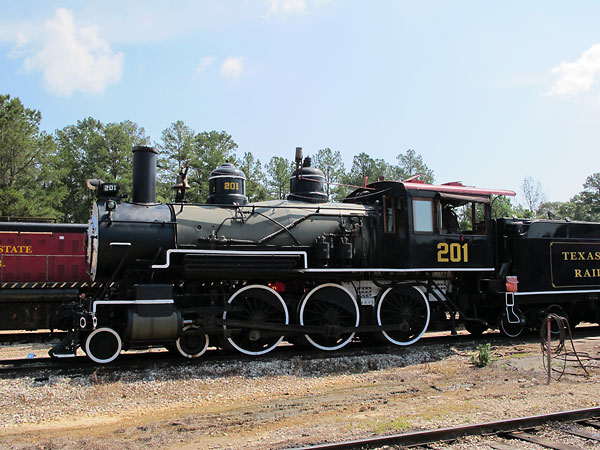
�
Engine number 201 is the oldest operable engine in the collection. Built in 1901 by the A.L. Cooke
�
Locomotive Works for the Texas & Pacific Railway, for freight service. In 1951 an anonymous donor
�
purchased the engine and donated it to the city of Abilene to honor their seventy-fifth anniversary.
�
It was displayed in Oscar Rose Park until 1974, when donated to the newly formed Texas State
�
Railroad. Engine 201 weighs 79 tons and can produce a tractive effort of 28,000 pounds.
�
| �
Technical Notes - Continued:�
� Even as steam enters one end of a locomotive's cylinder, it's being pushed out the other end.� Valve timing is always set so that the exhaust closes just before the end of the exhaust stroke,� which means that the piston is compressing steam at the end of its stroke. This cushions the heavy� piston and helps start it on its reverse movement, thereby reducing strain on the connecting rod bearings.� But a problem is that if too much water condenses in the cylinder it will be trapped and (usually)� result in a broken cylinder head. Such conditions occur, for example, as steam is admitted to the� cylinders of a locomotive after coasting down a hill for a time with no steam to the cylinders. It� can also be a problem on starting from rest, but the more likely result then is hydraulic lock and� not broken parts since little inertia is built up yet. For this reason, pressure relief valves were� built into some steam locomotives, and all steam locomotives have engineer-controlled cylinder drain� valves to let out condensed water. When these are open, great clouds of steam escape from the bottom� ends of the cylinders.� � Starting in the early 1900s locomotives were often equipped with devices something like intercoolers.� Actually, they didn't cool the steam - they "superheated" it. Still, the principle is that the steam� went through a device that changed the gas temperature before reaching the cylinders. Superheaters� are a series of U-shaped tubes that fit in the lower boiler flues where they are exposed directly to� the heat of the fire. This typically raises the steam temperature to between 500 and 700 degrees� (without changing the pressure, which is set by the boiler). Superheated steam will eliminate any� tendency for the steam to condense to water in the cylinders while running under average conditions.� Ordinary saturated steam suffers from slight condensation, and even small amounts of condensation� significantly lower the cylinder pressure and therefore reduce efficiency.� � Most readers are probably familiar with automotive turbochargers, which mechanically boost the� pressure of induction airflow. Similarly, practically all steam locomotives utilize a form of� exhaust induced combustion airflow! Locomotive boilers are very compact for the amount of steam� they have to produce, so natural airflow cannot begin to supply enough combustion air. The tried� and true solution is to have exhaust steam flow through an open venturi arrangement between the end� of the exhaust pipe and the smokestack. This exhaust flow creates a strong vacuum in the smokebox� that pulls air through the firebox. Like a turbo charger, this arrangement pulls more air under� heavy loads when it is needed most. When the locomotive is stopped, the engineer opens a valve that� supplies a small steam jet which keeps air flowing. Note that when the fire is first lighted in a� cold boiler, pressure build-up is slow until there is enough steam pressure to power the steam jet. � |
�
�
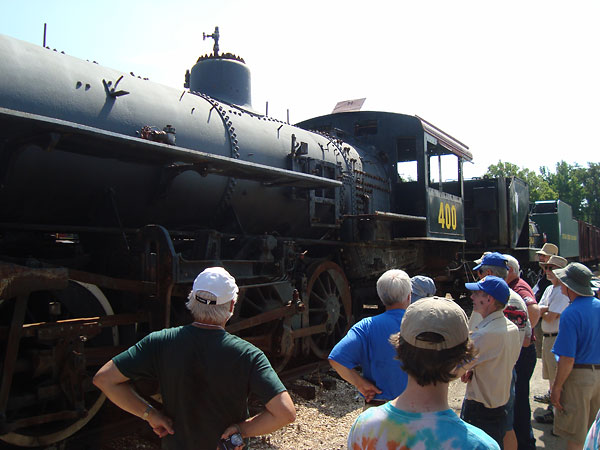
�
Engine number 400 was built by the Baldwin Locomotive Works in 1917 for the Tremont & Gulf Railway,
�
of Louisiana who operated it until 1954. It was sold to the Magma Copper Mine in Arizona. During its
�
years at the mine, it was used in the movie How the West Was Won (1962). The mine replaced its
�
steam engines with diesel in the late sixties, so it was available for the Texas State Railroad to
�
purchase. Engine 400 weighs 87 tons and can produce a tractive effort of 37,400 pounds.
�
| �
Technical Notes - Continued:�
� A big firebox is the key to more locomotive power. Just as with a car, the more fuel that the engine uses,� the more power that can be generated. Locomotive 300 (above) is similar to locomotive 400 (shown here)� except that locomotive 300 has its firebox over the rear drive wheels while locomotive 400 has its much� larger firebox behind the drive wheels. Both locomotives have similar starting tractive forces, meaning� both can get similar sized trains rolling. Tractive force is a function of number of driving wheels,� diameter of driving wheels, weight on the driving wheels, cylinder diameter, and boiler pressure - all� of which are similar for the two locomotives. However, locomotive 300 can only pull a heavy train at a� low speed because the fire cannot produce steam at a high rate, while locomotive 400 will pull the same� train at a significantly higher steady speed before steam production runs out. � |
�
�
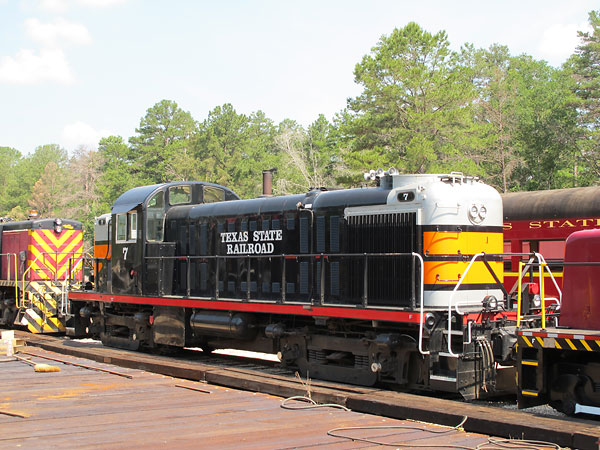
�
Engine number 7 is the second oldest diesel in the collection. Built in 1947 by the American Locomotive
�
Company (ALCO) at Schenectady, New York for Alcoa, it served the aluminum manufacturing plant at Point
�
Comfort, Texas. This engine represents the first wave of diesel engines that started replacing steam
�
engines immediately after WWII. Engine 7 weighs 120 tons and is rated 1500 horsepower.
�
| �
Technical Notes - Continued:�
� In the 1930s, the major steam locomotive companies: Baldwin (with Westinghouse electrical equipment),� Lima, and American Locomotive Company (with General Electric as a partner) were experimenting with diesels.� At the same time, General Motors was also building diesel locomotives as a new business venture� (Electro Motive Division or EMD). During WWII the government ordered the steam locomotive companies to� concentrate on steam locomotives but let GM develop diesels. At the end of the war, GM and the locomotive� manufacturers were joined by Fairbanks Morse who began building diesel locomotives using the highly successful� diesel generator sets they developed for submarines. (The Germans also used submarine technology on their� railroads in the form of electric commuter cars powered by submarine battery packs.) But GM was already� working on its second generation while the others were on their first generation. The technical lead GM� had built up could not be overcome and all the other manufacturers eventually stopped making locomotives.� However, General Electric dissolved its partnership with ALCO and continued on its own. GE is now the� dominant locomotive builder in the US. Westinghouse went into the nuclear power plant business and for a� while Baldwin built reactor pressure vessels using its expertise in metal fabrication. � |
�
�
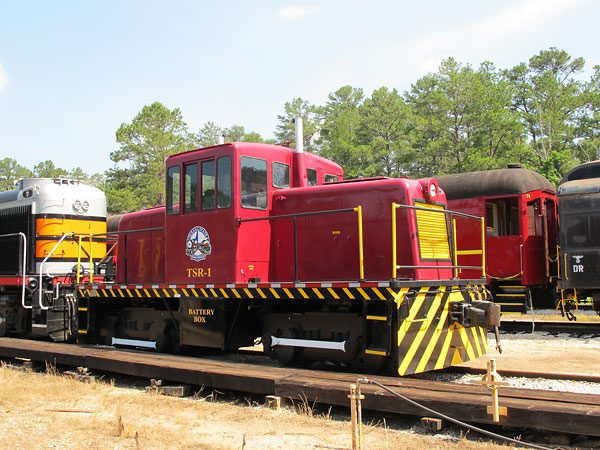
�
Engine number 1 is a General Electric "45 tonner" diesel switcher. This one was built in 1947. Its dual
�
150hp Cummins six-cylinder engines spin two separate generators, which in turn power dual traction
�
motors - one at each end. These little mules can push around up to twenty loaded freight cars.
�
However, because of their low gearing they typically can't travel faster than 20mph.
�
| �
Enjoying this article? Our magazine is funded through the generous support of readers like you! � To contribute to our operating budget, please click here and follow the instructions. � (Suggested contribution is twenty bucks per year. Feel free to give more!)� |
�
�
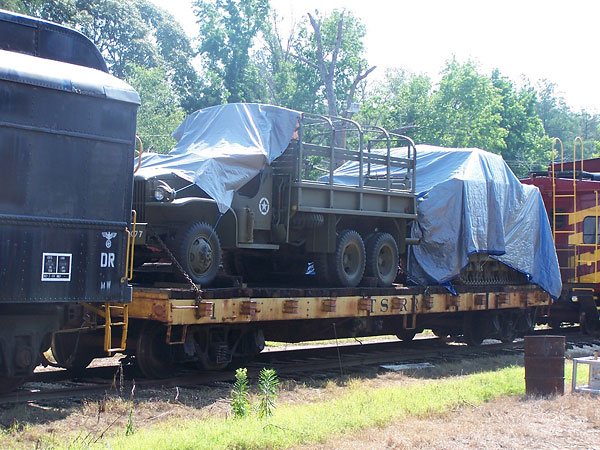
�
At the time of our visit, a collection of WWII military equipment was being prepared and loaded up
�
for a historical reenactment. A replica of General Patton's staff car had been specially prepared
�
for the purpose. Texas State Railway's collection have also appeared in quite a few motion pictures.
�
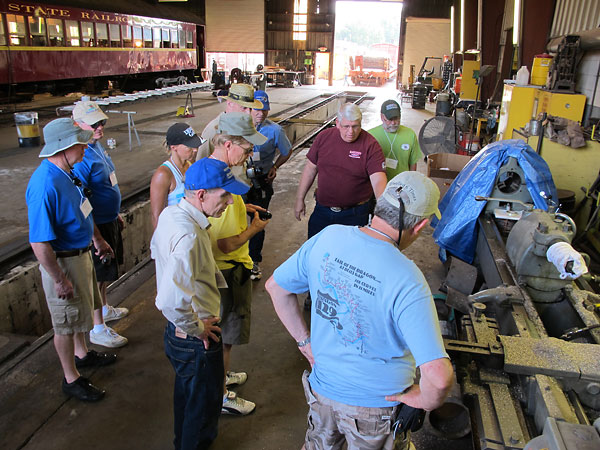
�
Yep, that's a really big lathe alright. So big, in fact, that it won't fit in the facility's main machine
�
shop. (The main machine shop was around the corner to the right.) The Texas State Railway staff
�
has to make a very high proportion of their own service and restoration parts from scratch.
�
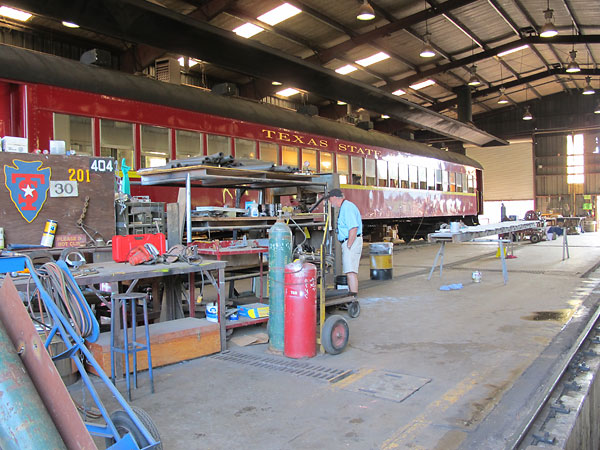
�
A large passenger car is currently in the workshop for restoration.
�
�

�
It took mountains of coal to power the steam trains, and it took mountains of wood to build them.
�
The Texas State Railway's steam locomotives have been converted to burn oil instead of coal,
�
but woodworking will remain a major part of the restoration shop's activity.
�

�
6500 gallons of water for engine 300. 5300 gallons of water for engine 201. Steam locomotives could
�
carry enough coal to travel long distances, but they typically had to stop every twenty miles or so
�
to refill the water supply for their boilers. The railroads employed people at all those watering
�
points, all across North America, not to mention huge legions of track maintenance people.
�
�
�
Disclaimer: This page was researched and written by Curtis Jacobson and Larry Shimp.�
Views expressed are those of the authors, and are provided without warrantee or guarantee.�
Apply at your own risk.�
�
Photos by Curtis Jacobson, Artie Clark and Graham Creswick for BritishV8 Magazine. All rights reserved.�

